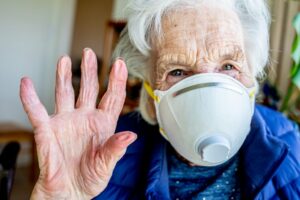New Guidelines for Nursing Home Visits
by Henry Fersko-Weiss
New visitation guidelines for nursing homes were issued on March 10th by the Centers for Medicare & Medicaid Services (CMS) in conjunction with the U.S. Centers for Disease Control and Prevention (CDC). These new guidelines, an update to ones in place since September of 2020, make it easier for people to visit nursing home residents regardless of vaccination status and even when some residents have tested positive for COVID-19 under conditions clearly spelled out by CMS.

Jeremy Poland/iStock by Getty Images
Presumably, these new procedures mean that doulas who have been engaged directly by families can visit. INELDA has tried multiple times, without success, to reach CMS to see if this is true. We will continue to pursue this information and let our community know if we learn something definitive about private practice doula visits. Doulas who work in a hospice-based program will have to follow the rules established by their hospice.
Nursing homes have been devastated by COVID-19 since the outbreak in the U.S. last year. The high rates of infection and death had led the CMS—the government agency responsible for the safety and health of nursing home residents—to severely restrict visitation to stop the spread of the virus. These measures meant that a single COVID-19 case would require a nursing home to remain closed for 14 days without any new COVID-19 cases before resuming visitation. Since then, the agency has recognized that such strict rules had a powerful emotional and psychological impact on residents and their loved ones.
The March 10th guidelines state that outdoor visits are still preferred, even when the resident and visitor are fully vaccinated. However, the new guidelines allow residents to receive indoor visits except under the following conditions:
- The resident is unvaccinated and the COVID-19 positivity rate in the facility’s county is greater than 10% and less than 70% of the residents in the nursing home are vaccinated.
- The resident has a confirmed COVID-19 infection and that resident has not met the criteria to discontinue preventive measures.
- The resident is in quarantine due to an exposure to COVID-19 and he or she has not yet met the criteria for release from quarantine.
In the event there is an outbreak in the facility, the CMS guidelines call for all visitation to stop until one round of facility-wide testing has been completed, at which time indoor visitation can resume in unaffected areas of the nursing home. Previously if there was an outbreak (even if it was contained within an isolated area) visitation for the entire nursing home would cease.
The revised guidelines also allow for compassionate care visits at end-of-life and for visits protected under federal disability rights law. These visits are now permitted at all times, regardless of a resident’s vaccination status, the county’s positivity rate, or an outbreak. If such a visit occurs indoors, they must still maintain an appropriate social distance. However, if the resident is fully vaccinated, they can choose to have close contact–including touch–if they wear a well-fitting mask and observe proper hand hygiene.
In spite of the new CMS and CDC guidelines, states are not required to implement them immediately. For example, New York state is reviewing the guidelines and has not yet determined to what extent they will adopt the changes. INELDA recommends checking with the specific facility before going to visit a nursing home resident to see if these new guidelines are in effect. For more information go to www.cms.gov
